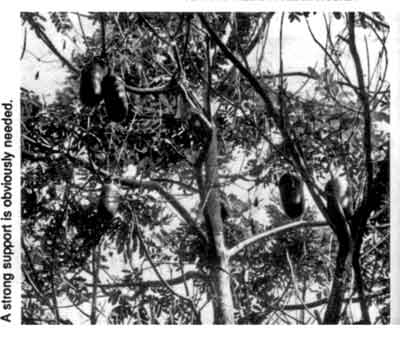
ROSARIO'S BLACK BEAUTY
SCIENTIFIC NAME: Sicana odorifera
FAMILY: Cucurbitaceae
Rosario Hill was excited as she cradled the 3+ pound cassabanana in her arms. The vine from which it came, the flowers that preceded the fruit, the large palmately-lobed leaves, all of these were no different from the textbook description of the plant. But in two respects the fruit was different: it was not the usual orange or crimson color, but rather a solid black; and it didn't have enough odor to justify its species name: Sicana odorifera. Here was something, which, while it will neither rock the horticultural or commercial world, was both new and different enough to make the grower feel very good and proud indeed. In a solemn ceremony, preceding its being slit from head to toe (or was it toe to head?), the black beauty was given the varietal name - Black Beauty. And having christened the baby, we ate it.
The Cucurbitaceae family includes some of our favorite foods: the watermelon, cantaloupes and other melons, gherkins, cucumbers, squashes, pumpkins, gourds, and luffa. Some are prostrate annuals and others are tendril-climbing vines; the leaves are usually large and often lobed; their flowers are mostly attractive and their production of seeds is prodigious. The Cassabanana, also known as the Pepino* or Curuba, is a fast-growing and attractive vine that is best planted next to a tree for support. Its leaves, which are shallowly palmately-lobed have a cordate base and can grow to about 12 inches across. The large leaves offset white or yellow flowers which may have a diameter of up to 3 inches. The single flowers, (only one grows at a node), are bell or urn-shaped and are monoecious. The fruit which grows from it is cylindrical, the stem end being flatter than the far end, which gives it the shape of a dirigible or a cannon shell, depending on the way you think.
A quick glance at the cassabananas as they hang from long stems high up in the tree would make you believe you are looking at a sausage tree (Kigelia pinnata), although their smooth rind is much more attractive than the 'sausages'.
The seeds are brown, about a ¼" long and slightly wider at the widest point. As you can see from the illustration, they have a distinctive, slightly depressed 'border' and a small beak at one end. They are very thin, perhaps a thirty-second of an inch at their widest point, and profusely distributed throughout the fruit.
This is a perennial plant and it is reported to grow as high as 50 feet into a tree. It is, like most of the family, tender to frost, and even if you didn't want to grow it for its food, it would make an attractive addition to another plain-looking tree with an open canopy.
As a food, judging from what I ate, its taste is pleasant enough if not outstanding, and if cooled in the refrigerator it would make a welcome fruit snack on a hot day. The profusion of pits is not a problem, as they are not attached to the flesh and they can be expelled in a variety of ways and directions, depending on your mood.
According to the literature, it can be used to make preserves, and blended with water, makes a mildly aromatic drink. Another book says it is also used as a boiled vegetable. It is mentioned as being used medicinally in Puerto Rico to relieve sore throats.
According to Rosario Hill, the seeds were received from Colombia and planted in December. The fruits, which achieved lengths of 10 to 12 inches and a diameter of 5 inches, ripened in September. Traditionally, a cassabanana is ripe when it begins to smell. In this case it was not a sure test.
It's too bad there is no 'Guiness' book of local varieties. Down here in South Florida, Bill Lessard would have his name in a few times, Bill Whitman, too. There's a Dovyalis var., Silas, named for Si Wood, and dozens of others. The same is true in every subtropical and tropical region, for botanical nature is very generous. The flowering plants are the Johnny-come-latelies of the Plantae Kingdom and they are still not through showing off their versatility: their genes haven't settled down yet. It isn't everyone, though, who has a variation show up in their garden, so when a Pepino de Color, "una negrita linda," a black beauty does say, "Good morning, world," the owner has a right to be proud. Who knows, sometime in the distant future when there is a Hortus 33, Black Beauty might get a nod.
* Ed's note: there is another fruit, Solanum muricatum, which is also called 'Pepino'.
 |  |
| Rosario with her Black Beauty | Cassabanana vine in large tree. |
DATE: January 1991
* * * * * * * * * * * * *
